
Inertia is a property of matter that describes its resistance to changes in motion. It is the natural tendency of an object to maintain its current state of rest or uniform motion unless acted upon by an external force. In other words, an object at rest will stay at rest, and an object in motion will continue moving with the same speed and in the same direction, unless an external force is applied to alter its motion. The concept of inertia helps explain why objects require a force to start moving, stop moving, or change their direction.
Examples
Moving bike

When a moving bike applies a sudden brake, the person sitting on the back seat will slightly move forward. This forward movement of the person at the back clearly demonstrates inertia in action. Inertia refers to the tendency of a moving body, in this case, the person sitting at the back, to keep moving unless acted upon by an external force, which in this case is the brakes. Therefore, it is important to hold onto something when sitting on a moving bike to maintain stability and avoid being affected by inertia.
Seat belt
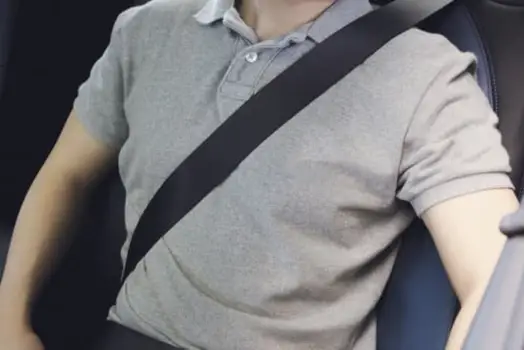
While sitting in a moving car and wearing a seat belt, one can observe that when the brakes are applied, the seat belt tightens. This tightening of the seat belt clearly demonstrates the principle of inertia. Due to inertia, even after the brakes are applied, the upper body continues to move forward. The seat belt acts as an external force that prevents the body from being thrown away from the car seat. It ensures the safety and restraint of the occupant during sudden deceleration or collision.
Rubber ball
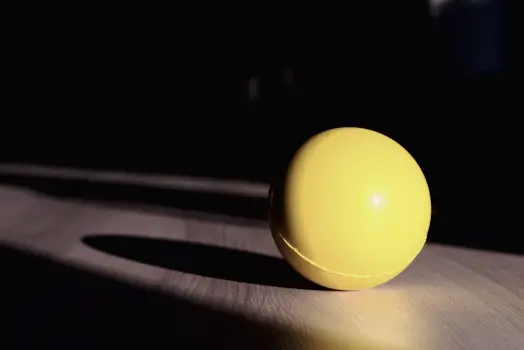
When a rubber ball is placed on a slanted surface and allowed to roll, it exhibits the principle of inertia. The ball will continue rolling without stopping on its own, demonstrating that objects in motion tend to stay in motion. This behavior showcases the concept of inertia, which states that an external force, such as friction, is required to bring a moving object to a halt. Without the presence of friction, the rubber ball will maintain its forward momentum and continue rolling indefinitely.
Dusting
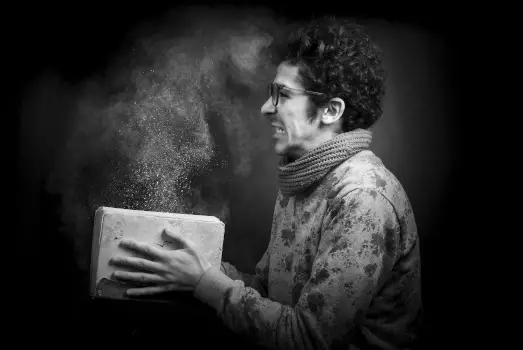
Inertia can be observed when dusting an old book by hand, as dust particles are released into the air. Due to inertia, the dust particles inside the book initially remain at rest and will continue to stay at rest unless an external force, such as the force applied by the hand, acts upon the book.
Milk swirl

When milk is stirred in a large container, it does not come to an immediate halt, but rather continues to swirl for some time. This persistence of swirling is attributed to inertia. Inertia causes the milk to maintain its rotational motion even after the stirring has ceased.
Car

When starting or stopping a car, inertia is at work. Inertia is the tendency of an object to resist changes in its state of motion. As the car accelerates forward, passengers may feel a slight backward push. This is because their bodies, initially at rest, resist the change in motion due to inertia. Similarly, when the car suddenly stops, passengers may experience a forward lurch as their bodies resist the change in motion. In both cases, inertia causes the passengers to resist the change until an external force, such as the friction between the seats and the passengers, counteracts it.
Water droplets

When a wet branch of a tree is shaken, water droplets fall to the ground, illustrating the presence of inertia. The water droplets initially remain at rest on the tree branch and will continue to do so unless acted upon by an external force. When the branch is shaken by applying a force with the hand, the water droplets are set in motion and fall to the ground. This behavior of the water droplets highlights the concept of inertia, which states that objects at rest tend to stay at rest until an external force is applied.
Napkin

When a napkin placed underneath a dish is quickly pulled with your hand, the napkin effortlessly comes out. This phenomenon demonstrates the concept of inertia. Initially, the dish was in a resting position, and due to inertia, it tends to remain in that resting position even after the napkin is pulled.
Flowing water
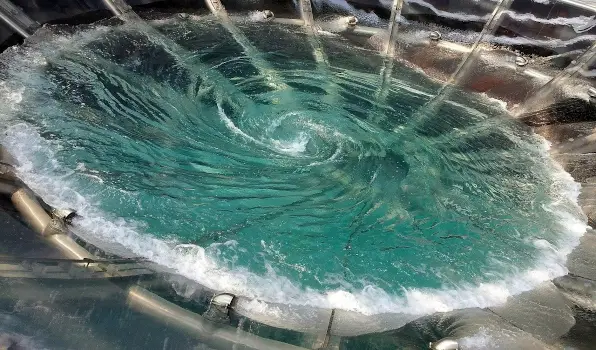
The phenomenon of water continuing to swirl in a large container, even after the main flow of water stops, is a clear demonstration of inertia. Inertia is the tendency of objects to resist changes in their motion. In this case, the water, once set in motion, continues to swirl due to its inertia. It takes time for the circular motion to stop because the water particles want to keep moving in their original path.
Ice skating
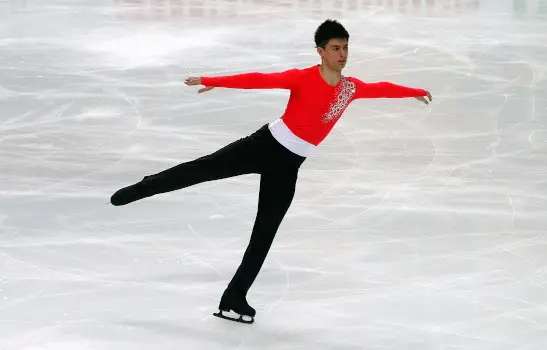
When a person skates on the ice, they continue to slide for a certain distance even after they stop pushing themselves forward. This happens due to inertia, which is the tendency of an object to resist changes in its motion. In this case, the person’s body, initially in motion, wants to keep moving forward. It is the external force of friction between the skates and the ice that eventually slows them down and brings them to a stop.
Hovercraft
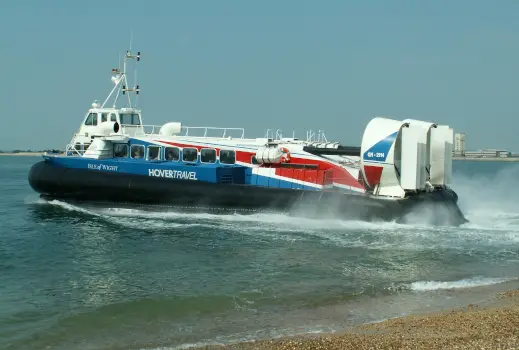
Stopping or changing the direction of a hovercraft in the sea can be challenging. When a hovercraft comes to a stop, it does not immediately halt due to the absence of strong friction forces. Instead, it continues to move in the same direction for a period of time. This behavior is a result of inertia, which is the resistance of an object to changes in its motion. The hovercraft, like other objects, tends to maintain its current state of motion until an external force, such as friction or air resistance, acts upon it to slow it down or change its course.
Tree branch

When wind blows, a branch of a tree can be observed swaying in the air. This behavior can be attributed to inertia. The branch, initially at rest, tends to remain in its current state unless acted upon by an external force. When the wind exerts its force on the branch, it causes the branch to sway and move in the air.
Bicycle ride

Consider a scenario where a bicycle is being ridden on a sloping surface and the rider ceases to pedal. In this situation, due to the property of inertia, the bicycle will continue moving forward. However, over time, the external force of friction will come into play, causing the bicycle to gradually slow down.
Card experiment
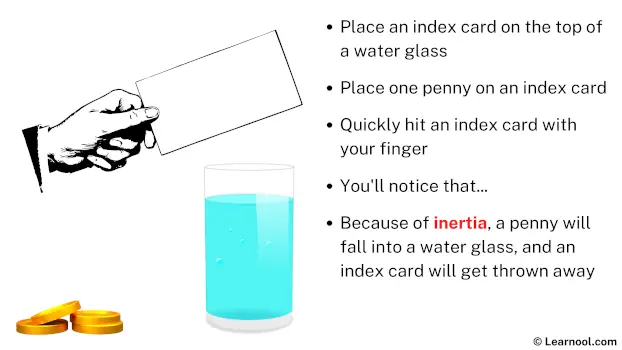
Imagine a scenario where an index card is placed on top of a water glass, with a penny resting on the card. When the index card is swiftly struck with a finger, an intriguing phenomenon occurs. The penny, due to its inertia, maintains its position and remains at rest. However, the force exerted by the striking motion causes the index card to be propelled away, while the penny falls into the water glass. This occurrence highlights the concept of inertia, wherein objects tend to resist changes in their state of motion unless acted upon by external forces.
Related
More topics
- Air resistance examples
- Gravity examples
- Inertia examples
- Acceleration examples
- Momentum examples
- Mass examples
- Velocity examples
- Friction examples
- Frame of reference examples
Image credit
- The stock photos used in this post are sourced from platforms like Pexels, Pixabay, Canva, etc. Due to the age of the images, their specific origins remain unknown.
External links
- Examples of Inertia – YourDictionary
- Inertia: Definition, Formula, Examples & Law – Vaia
- What is an example of inertia? – Quora
- Inertia – Wikipedia
- Inertia and Mass – The Physics Classroom
- What are some examples of inertia? – Socratic
- Inertia Definition & Meaning – Merriam-Webster
- Inertia Examples – SoftSchools.com
- Definition and examples of inertia – Basic Mathematics
- What is inertia? – New Scientist
- Inertia Lesson for Kids: Definition, Law & Examples – Study.com
- Inertia: Definition and Types with Examples – PhysicsGoEasy
- Inertia Definition & Meaning – Dictionary.com
Deep
Learnool.com was founded by Deep Rana, who is a mechanical engineer by profession and a blogger by passion. He has a good conceptual knowledge on different educational topics and he provides the same on this website. He loves to learn something new everyday and believes that the best utilization of free time is developing a new skill.
